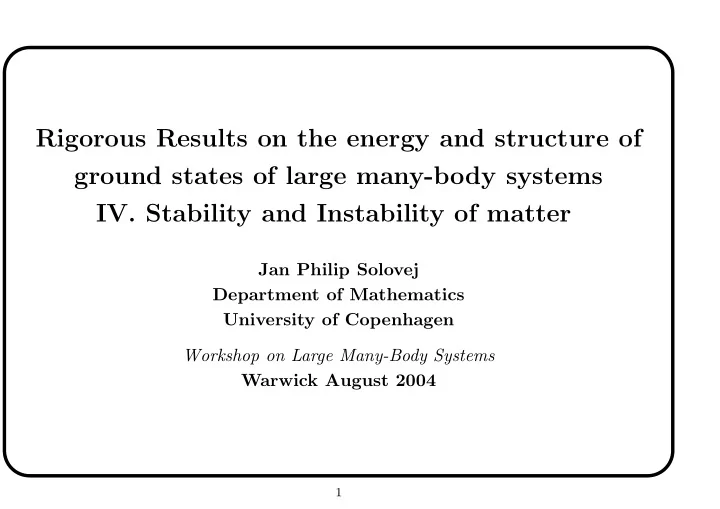

Rigorous Results on the energy and structure of ground states of large many-body systems IV. Stability and Instability of matter Jan Philip Solovej Department of Mathematics University of Copenhagen Workshop on Large Many-Body Systems Warwick August 2004 1
List of Slides 3 The Theorem on Stability of Matter 4 Correlation estimates 5 A proof of stability of matter 6 Instability of bosonic matter 7 Heuristic derivation of Dyson’s formula 8 Conclusion 2
The Theorem on Stability of Matter My goal in this last lecture is to discuss stability of fermionic matter and instability of bosonic matter. THEOREM 1 (Stability of Matter). Matter consisting of nuclei and fermionic electrons satisfies stability of the 2nd kind E F N,K > − C ( N + K ) . This was first proved by Dyson and Lenard. Shortly after Lieb and Lebowitz used this to prove that the thermodynamic limit exists for ordinary matter. Lieb and Thirring later gave a simplified proof of stability of matter using the Lieb-Thirring inequality and Thomas-Fermi theory . In Thomas-Fermi theory one has the celebrated No-binding theorem . I will sketch a somewhat different proof based on a correlation inequality of Baxter; still using the Lieb-Thirring inequality. 3
Correlation estimates THEOREM 2 (Baxter’s correlation estimate). For all z 1 , . . . , z M ∈ R and x 1 , . . . , x M ∈ R 3 . � � z i z j | x i − x j | − 1 ≥ z i V ( x i ) i, z i < 0 1 ≤ i<j ≤ M where j : z j > 0 {| x − x j | − 1 } . V ( x ) = (2 max k { z k } + 1) max An improvement (and more analytic proof) of this was given by Lieb and Yau. A simpler version was proved already by Onsager in 1939: M � � z i z j | x i − x j | − 1 ≥ − j : z i z j < 0 {| x i − x j | − 1 } z 2 max i 1 ≤ i<j ≤ M i =1 4
A proof of stability of matter For matter with electrons of charge -1, Baxter’s correlation inequality gives N � − 1 H N,K ≥ 2 ∆ i − V ( x i ) i =1 where j : z j > 0 {| x − x j | − 1 } V ( x ) = (2 max k { Z k } + 1) max By the Lieb Thirring inequality � V ( x ) 5 / 2 − N sup E N,K ≥ − C LT V. R 3 \ Λ Λ With an appropriate choice Λ ⊂ R 3 we find E N + K ≥ − C ( N + K ) . 5
Instability of bosonic matter THEOREM 3 (Dyson’s formula. Lieb-Sol. 2004 ( ≥ ), Sol. 2004( ≤ )) . � � � � � E B |∇ φ | 2 − J φ 5 / 2 | φ ≥ 0 , φ 2 = 1 N 1 lim N 7 / 5 = inf 2 N →∞ History: Dyson 1967 proved E B N ≤ − CN 7 / 5 . Implies no stability (7 / 5 > 1). No thermodynamics. Dyson conjectured above formula. Conlon-Lieb-Yau 1988: E N ≥ − CN 7 / 5 . A Hartree trial state φ ( x 1 ) · · · φ ( x N ) would give � � | φ ( x ) | 2 | φ ( y ) | 2 � |∇ φ | 2 + E B N 1 ≤ z i z j dxdy 2 | x − y | 1 ≤ i<j ≤ N �� � � | φ ( x ) | 2 | φ ( y ) | 2 N |∇ φ | 2 − = dxdy , 2 | x − y | i.e., linear in N , assuming that � i z i = 0 and � i z 2 i = N . 6
Heuristic derivation of Dyson’s formula � � φ 2 = 1. Most particles are in condensed state � φ with The local density is ρ = N � φ 2 . Local energy density is according to Foldy − Jρ 5 / 4 = − JN 5 / 4 � φ 5 / 2 . It is not quite that simple. One again has to do a Bogolubov approximation. In this special case the Bogolubov approximation is in fact an exact upper bound. The local energy density is however still an approximation. � |∇ � The kinetic energy of the condensate is 1 φ | 2 2 N The total energy is then � � φ | 2 − JN 5 / 4 |∇ � � φ 5 / 2 1 2 N If we set φ ( x ) = N − 3 / 10 � φ ( xN − 1 / 5 ) then � � � � � � φ | 2 − JN 5 / 4 φ 5 / 2 = N 7 / 5 |∇ φ | 2 − J |∇ � � φ 5 / 2 1 1 2 N . 2 7
Conclusion I have in these lectures discussed non-relativistic many-body quantum mechanics and reviewed som rigorous results. Among the things I have not discussed one can mention • Excited states and positive temperature • Relativistic effects and corrections • Coupling to quantum fields, such as the electromagnetic field or other gauge fields or coupling to the gravitational field. • Perturbation theory 8
Recommend
More recommend